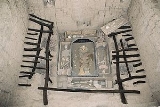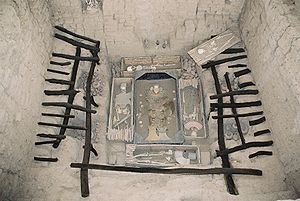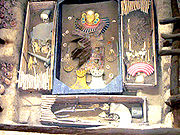
Lord of Sipán
Encyclopedia

Mummy
A mummy is a body, human or animal, whose skin and organs have been preserved by either intentional or incidental exposure to chemicals, extreme coldness , very low humidity, or lack of air when bodies are submerged in bogs, so that the recovered body will not decay further if kept in cool and dry...
of an elite man found in Sipán
Sipán
Sipán is a Moche archaeological site in northern Peru that is famous for the tomb of El Señor de Sipán , excavated by Walter Alva and his wife Susana Meneses. It is considered to be one of the most important archaeological discoveries in the last 30 years, because the main tomb was found intact...
by Peru
Peru
Peru , officially the Republic of Peru , is a country in western South America. It is bordered on the north by Ecuador and Colombia, on the east by Brazil, on the southeast by Bolivia, on the south by Chile, and on the west by the Pacific Ocean....
vian archaeologist
Archaeology
Archaeology, or archeology , is the study of human society, primarily through the recovery and analysis of the material culture and environmental data that they have left behind, which includes artifacts, architecture, biofacts and cultural landscapes...
Walter Alva
Walter Alva
Walter Alva , full name is Walter Alva Alva, is a Peruvian archaeologist, specializing in the study and excavation of the prehistoric Moche culture. Alva is noted for two major finds: the tomb of the Lord of Sipan and related people in 1987, and 2007.-Early life and education:Alva was born on 28...
in 1987. The tomb is in Sipán's Huaca Rajada, an area in Chiclayo
Chiclayo
Chiclayo is the capital city of the Lambayeque region in northern Peru. It is located 13 kilometers inland from the Pacific coast and 770 kilometers from the nation's capital, Lima...
.

Moche
'The Moche civilization flourished in northern Peru from about 100 AD to 800 AD, during the Regional Development Epoch. While this issue is the subject of some debate, many scholars contend that the Moche were not politically organized as a monolithic empire or state...
culture site in Peru. Some archaeologists hold it to be one of the most important archaeological discoveries in this region of the world in the last 30 years, as the main tomb was found intact and untouched by thieves.
Sipán is located in the northern part of Peru, close to the coast, in the middle of the Lambayeque Valley, 35 km east of Chiclayo, Peru. Four tombs have been found in Sipán's Huaca Rajada. This was a burial mound, a kind of mausoleum, built by the Moche culture. Its people ruled the northern coast of Peru
Peru
Peru , officially the Republic of Peru , is a country in western South America. It is bordered on the north by Ecuador and Colombia, on the east by Brazil, on the southeast by Bolivia, on the south by Chile, and on the west by the Pacific Ocean....
from around 1 AD to 700 AD.
Location
The town of SipánSipán
Sipán is a Moche archaeological site in northern Peru that is famous for the tomb of El Señor de Sipán , excavated by Walter Alva and his wife Susana Meneses. It is considered to be one of the most important archaeological discoveries in the last 30 years, because the main tomb was found intact...
, in the Zaña district, is roughly around 20 miles east of the city of Chiclayo
Chiclayo
Chiclayo is the capital city of the Lambayeque region in northern Peru. It is located 13 kilometers inland from the Pacific coast and 770 kilometers from the nation's capital, Lima...
and 45–50 miles away from Lambayeque
Lambayeque
The name Lambayeque originates from "Llampayec", an idol that was worshipped in northern Peru. It can refer to the following Peruvian locations:* The city of Lambayeque, Peru* The Lambayeque District* The Lambayeque Province* The Lambayeque Region...
. The site belonged to the Moche (Mochican) culture that mainly worshipped the god called Ai Apaec (Ayapec) as "principal" god or deity.
Clothing and ornaments
The clothing of this warrior and ruler suggest he was approximately 1.67 m tall. He probably died within three months of governing. His jewelry and ornaments indicate he was of the highest rank, and include pectoral, necklaces, nose rings, ear rings, helmets, falconry and bracelets. Most were made of gold, silver, copper and semi-precious stones. In his tomb were found more than 400 jewels.The Lord of Sipán was wearing a precious necklace with beads of gold and silver in the shape of maní (peanuts) represent the tierra (earth). The peanuts symbolized that men came from the land, and that when they die, they return back to the earth; the Moches harvested peanuts for food. The necklace has 10 kernels to the right, which are gold, signifying masculinity and the sun god, while the kernels on the left side are silver, to represent femininity and the moon god.
Grave
Because of his high rank, the ruler was buried with eight people, apparently his wife and two other women (possibly concubines), a military commander, a watchman, a banner holder and a child. Among the animals found was a dog.Older tombs
Below the tomb of the Lord of Sipan, two other tombs were found: that of a priest and of the Old Lord of Sipan. DNA analysis of the remains established that the priest was contemporary with the Lord of Sipan. Artifacts in his tomb are believed to be related to religion: the cup or bowl for the sacrifices, a metal crown adorned with an owl with its wings extended, and other items for worship of the moon.DNA analysis of remains of the Old Lord of Sipan proved that he was a direct ancestor of the Lord of Sipan. In his tomb were found the remains of a young woman, a likely sacrifice to accompany him to the next life. Also there were sumptuous costumes embroidered with gold and silver.
DNA testing
Archeological research and DNA testing enabled deducing certain physical characteristics of the ruler, such as skin color, the form of his lips, hair, eyes and other facial features. It was also possible to provide an accurate estimate of his age at death, allowing for a more accurate facial reconstruction by researchers.Museum

Lambayeque, Peru
Lambayeque is a city in the Lambayeque region of northern Peru. It is notable for its exceptional museums featuring artefacts from local archaeological sites. The Bruning Museum, established in the early 1900s, contains hundreds of gold and silver pieces, as well as textiles and ceramics, from the...
. (which also happens to be in the "state" of Lambayeque) in Peru. The museum was designed to resemble the ancient Moche tombs (with the exception of giant golden figures on the side).
The museum's main attraction is the Lord of Sipan and his entourage, who accompanied him to the afterworld with him. The warriors who were buried with him had amputated feet, as if to prevent their leaving the tomb. The women were dressed in ceremonial clothes. Dogs, llamas, and more than 80 huacos (works of ceramic pottery) were also buried in the tomb.
External links
- "Archaeology of Sipan and Huaca Rajada"
- "Interview with Walter Alva", UNESCOUNESCOThe United Nations Educational, Scientific and Cultural Organization is a specialized agency of the United Nations...
- "Lord Sipan", Delange, Photo gallery of artifacts from the tomb
- Photos, videos, and 3D animation of tombs

